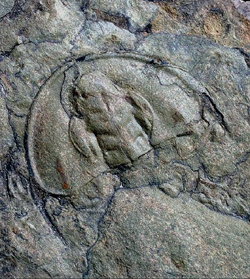 Although the
oldest fossils of land plants date back 470 million years, genetic studies have
concluded that plants had already made the move from sea to land by 700 million
years ago. According to climate modeler Werner von Bloh and colleagues at the
Potsdam Institute for Climate Impact Research, the weathering of rock by these
early land plants removed carbon dioxide from the atmosphere, and caused a gradual
climatic cooling that set the stage for the evolution and radiation of more
complex multicellular life.
Although the
oldest fossils of land plants date back 470 million years, genetic studies have
concluded that plants had already made the move from sea to land by 700 million
years ago. According to climate modeler Werner von Bloh and colleagues at the
Potsdam Institute for Climate Impact Research, the weathering of rock by these
early land plants removed carbon dioxide from the atmosphere, and caused a gradual
climatic cooling that set the stage for the evolution and radiation of more
complex multicellular life. This Olenellid trilobite in the Wood Canyon formation from Death Valley, Calif., is just one example of the plethora of life from the fossil record during the Cambrian explosion. Image copyright by Martin Miller, University of Oregon, courtesy of the Earth Science World Image Bank.
In the team’s model, global surface temperatures were falling in the late Proterozoic, dropping below the required threshold temperature for complex life of 30 degrees Celsius (86 degrees Fahrenheit) at the Cambrian boundary, and continued falling until surface temperatures reached about 15 degrees Celsius (59 degrees Fahrenheit). “We assume that if you reach 30 degrees Celsius, then you have the first appearance of higher life forms. And they increase weathering on the planet, which tends to cool it, so we have a positive feedback,” von Bloh says. “Then you have a drastic drop in temperature, and a drastic increase in biomass.”
However, some scientists question whether falling temperatures would be a prerequisite for the evolution and radiation of complex life. Currently, many believe that a climatic warming, not a cooling, probably triggered the biological big bang.
“The Cambrian explosion is triggered by a cooling in their model, whereas … the early Cambrian was warm, according to the geologic record,” says James Kasting, a climatologist at Pennsylvania State University.
The cause of the Cambrian explosion is one of the most important unanswered questions in the field of paleontology. Most other hypotheses explaining the Cambrian explosion include some element of increasing temperature or increasing atmospheric oxygen. For example, the snowball Earth hypothesis suggests that rising temperatures following a global glaciation around 600 million years ago allowed previously ice-bound organisms, which had been evolving in geographic isolation, to thrive and radiate into the various groups we see today. The oxygen hypothesis holds that the breakup of the supercontinent Rodinia changed ocean circulation patterns, increasing nutrient upwelling and, therefore, also primary production and oxygen.
However, the implications of the new model are in keeping with the Gaia hypothesis, which suggests that Earth’s biosphere (life), geosphere (solid Earth), and hydrosphere (water) make up a self-regulating system, governed by feedbacks, that tends toward the conditions necessary for life.
In fact, von Bloh’s team originally designed the model to study how Earth’s biosphere and geosphere evolved together. In the model, three types of life populate the biosphere: prokaryotes (unicellular life without a nucleus), eukaryotes (unicellular life with a nucleus) and multicellular life. The researchers assigned each group certain temperature tolerances, above and below which they could not exist.
According to the results, published in the October Geophysical Research Letters, two stable states exist for the biosphere: with and without complex multicellular life. Switching from one state to another, von Bloh says, can be triggered by some disturbance to the Earth system that would increase weathering or temporarily cool the planet — such as a continental break-up, a meteorite impact, or a global glaciation.
Once that disturbance occurs, von Bloh says, multicellular life, in the form of land plants, takes hold and begins to spread, increasing the rate of weathering and erosion. The resulting removal of carbon dioxide from the atmosphere (by binding with calcium from weathered rock to form calcium carbonate) would further produce and maintain the cool conditions he says are necessary for complex life.
Whether those conditions actually existed is open to debate. Von Bloh says it’s very difficult to find geologic evidence of ancient surface temperatures. And, Kasting says, von Bloh’s model does not reflect some known climate data. For example, the model’s predicted surface temperature is 45 degrees Celsius (113 degrees Fahrenheit) during a glacial period around 2.3 billion years ago, Kasting says.
Still, understanding why complex life evolved on Earth only 540 million years ago, despite more than 3 billion years of prior opportunity, has important implications, especially in the field of astrobiology.
Astronomers who want to identify planets with potential life may benefit by looking at the parameters under which it evolved on Earth, von Bloh says, as well as the parameters under which it could have evolved. The question to answer, he says, is “would every Earth-like planet have a Cambrian explosion at a certain time, or is it possible to have the Cambrian explosion earlier or later?”
According to the model, a potential cold snap during the Proterozoic could have triggered the explosion of life on Earth up to 1.2 billion years sooner. This wider window of opportunity for life to spring forth could make the task of identifying the conditions for a habitable planet even more daunting.

